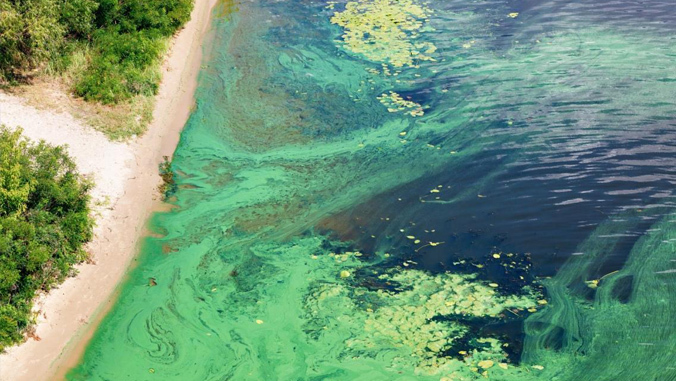The discoveries are a boon to world history, offering rare insight into lost pieces of humanity’s past and ancient life on Earth.
But their exposure sets off a race against time for researchers, who have only a short window to study them before the rivers recede.
“We’re amazed at how quickly things emerge and then disappear in the blink of an eye,” said Vincent Santucci, senior paleontologist with the National Park Service who has excavated fossils from eroding cliffs and shorelines. “When we have low water levels, there’s a lot of things that are exposed that we haven’t seen in our lifetime and may never have been documented. We rush to preserve them.
At Dinosaur Valley State Park in Glen Rose, Texas, weeks of scorching heat have dried up the Paluxy River, revealing multiple sets of dinosaur footprints that experts say date back 113 million years.
Some came from a creature called Acrocanthosaurus, a bipedal, three-toed carnivore that resembled a slightly smaller Tyrannosaurus rex, according to park spokeswoman Stephanie Garcia. As an adult, he would have stood about 15 feet tall and weighed about seven tons. Another set of footprints came from a four-legged, long-necked herbivore called Sauroposeidon that was 60 feet tall and weighed about 44 tons.
Although dinosaur tracks aren’t particularly rare, they are important to researchers because they provide clues to how the animals lived.
“The tracks were traced along an ancient inland sea during the Cretaceous period,” Garcia told The Washington Post. “Dinosaurs walked in thick mud that retained the shape of their tracks well with great detail.”
With rain in the forecast ahead, Garcia said the slopes will soon be covered again. Workers cleaned, mapped, measured and photographed the tracks to track changes over time. The park is also considering other solutions that would allow the tracks to survive longer if exposed again, according to Garcia.
“However,” she added, “nothing the park can do can stop the forces of weathering and erosion forever.”
Repeated cycles of exposure and covering can wear down fossils that would otherwise be protected by silt and sediment. Water returning to a dry area can erode rock and shoreline. Loose debris could bury or damage delicate specimens. Other fossils risk being swept away by the advancing current. Intense storms present similar dangers.
These threats are accelerating as climate change worsens, adding pressure on scientists and field workers to protect their discoveries before they are destroyed or taken away, said Santucci, of the National Park Service.
“Given the wild fluctuations in weather and rainfall, we can have these long dry spells exposing things and then catastrophic flooding,” he said. “The high-energy nature of these floods can completely wipe out a fossil site.”
In special cases, said Santucci, specimens are collected for safekeeping. Most often, scientists inventory what they find, draw maps, take photos, and even build 3D models. Then they develop a periodic site monitoring plan to see what changes over time. Ultimately, Santucci said, they are at the mercy of nature.
“We need to make schedules to get there very quickly,” he said, “before they get lost forever.”
In the rapidly drying Danube, Europe’s second-longest river, researchers investigating a cemetery of Nazi warships exposed by record-breaking waters could face similar problems.
The World War II ships discovered near the Serbian port city of Prahovo in August were part of a German Black Sea Fleet that sank in 1944 as it retreated from Soviet forces. More than 20 have appeared so far, with more expected to be discovered along the banks.
It is a treasure trove for maritime specialists and military historians. But it’s also riddled with dangers: Serbian officials say there could be thousands of cartridges and other unexploded explosives inside.
Even if the searchers can reach the ships safely, they will face a lack of time. In the short term, the waters will return, recovering the sunken vehicles. In the longer term, rising and falling water levels driven by intensified drought expose metal structures to sunlight, rust-causing oxygen, and potentially volatile river conditions. which could affect their longevity.
“Whenever we introduce natural or cultural interference, we talk about degradation and think about how long these sites will last,” said Jennifer McKinnon, a maritime archaeologist at East Carolina University.
“The flip side is that their discovery is a great opportunity to raise awareness, for the global community to understand history and see what only divers could have seen,” she said. “There’s going to be destruction, but you also understand the importance of this public exposure.”
While the Danube reveals the destructive side of man, other rivers have revealed a host of displays of creativity in recent months.
Buddhist statues built during the Ming and Qing dynasties have popped up on an island reef in the Yangtze, which is experiencing record high water levels. In Spain, archaeologists recently gained access to an ancient monument known as the “Spanish Stonehenge” in a reservoir in the Tagus; it has rarely been visible since the area was flooded in the 1960s to build a dam. And in Iraq, the remains of a 3,400-year-old city emerged in June when drought sapped the waters of a reservoir in the north of the country.
The ephemeral sight of these treasures has an enormous ecological cost. Drought is ravaging crops, depleting livestock and native species. It deteriorates air quality and increases the risk of forest fires, among other environmental ills. As the planet heats up, these cycles are almost certain to continue.
“We can consider it a double-edged sword,” Santucci said. “We can document the adverse effects of climate change, but benefit from discovering things that have been exposed due to the same factors.”




